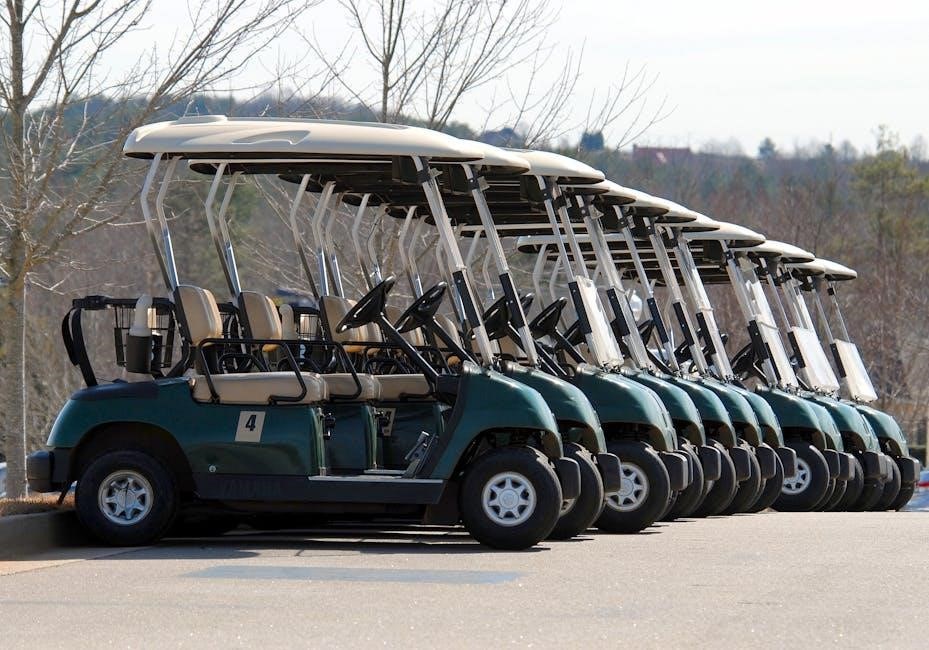Club Car golf cart troubleshooting is essential for maintaining performance and addressing common issues. This guide helps identify and resolve problems like battery faults, motor issues, and electrical malfunctions efficiently.
1.1 Importance of Regular Maintenance
Regular maintenance is crucial for ensuring your Club Car golf cart operates smoothly and efficiently. It helps prevent common issues like battery drain, electrical faults, and mechanical breakdowns. By routinely inspecting batteries, brakes, and electrical connections, you can identify and address problems early, reducing downtime and extending the cart’s lifespan. Proper upkeep also enhances safety, performance, and reliability, making it a vital part of owning and using a Club Car golf cart effectively.
1.2 Common Issues in Club Car Golf Carts
Club Car golf carts often encounter issues such as low battery power, faulty chargers, and loose or corroded battery terminals. Motor problems, including surging or failure to start, are also common. Brake failures and spongy pedals can occur, while steering difficulties and drift may arise from misalignment. Electrical system faults like blown fuses or tripped breakers frequently cause operational disruptions. Addressing these issues promptly ensures optimal performance and longevity of your Club Car golf cart.

Battery-Related Problems
Battery issues are common in Club Car golf carts, often caused by low power, faulty chargers, or loose/corroded terminals. Regular testing and maintenance are crucial for optimal performance.
2.1 Low Battery Power
Low battery power is a common issue in Club Car golf carts, often causing sluggish performance or failure to start. Symptoms include dim lights, slow acceleration, and weak motor response. Causes may include deep discharging, aging batteries, or faulty charging systems. To troubleshoot, check charge levels, ensure connections are tight, and test individual batteries for voltage. If issues persist, consider replacing old or damaged batteries to restore optimal performance and reliability.
- Check battery charge levels regularly.
- Inspect connections for tightness and corrosion.
- Test battery voltage to identify weak cells.
2.2 Faulty Charger
A faulty charger can prevent your Club Car golf cart from charging properly, leading to low battery power and poor performance. Symptoms include the charger not turning on, inconsistent charging cycles, or error codes like flashing lights. Check for loose connections, damaged cords, or blown fuses. Ensure the charger is compatible with your battery type and test it on another cart if possible. If issues persist, replace the charger to maintain reliable battery performance and avoid further complications.
- Inspect the charger cord for damage or frays.
- Check for error codes or unusual lighting patterns.
- Test the charger on a different cart to confirm functionality.
2.3 Loose or Corroded Battery Terminals
Loose or corroded battery terminals can disrupt power flow, causing intermittent performance issues in your Club Car golf cart. Check for visible corrosion or loose connections, as these can prevent proper charging and lead to low battery power. Clean terminals with a wire brush and tighten connections securely. If corrosion is severe, consider replacing the terminals to ensure reliable electrical contact and consistent performance.
- Inspect terminals for corrosion or damage.
- Clean terminals with a wire brush to remove corrosion.
- Tighten all connections firmly to ensure proper contact.
2.4 Testing Battery Connections
Testing battery connections is crucial for diagnosing electrical issues in your Club Car golf cart. Use a multimeter to measure voltage at the terminals to ensure it matches the expected reading. Check for loose connections by gently tugging on cables, and inspect for corrosion. Sparks when disconnecting cables may indicate a short circuit. Test continuity across connections to confirm proper flow. Clean or replace faulty connections to restore reliable power delivery.
- Use a multimeter to measure terminal voltage.
- Check for loose or corroded connections.
- Test continuity to ensure proper electrical flow.

Controller Malfunctions
Controller malfunctions can cause erratic acceleration, faulty direction switches, or complete operational failure. Diagnosing issues involves testing solenoids and connections to ensure proper electrical signals are transmitted.
3.1 Symptoms of a Faulty Controller
Symptoms of a faulty controller include erratic acceleration, sudden stops, or failure to respond to directional commands. The cart may surge or jerk unpredictably, and speed control becomes inconsistent. In some cases, the motor may not start at all, or there could be unusual noises from the electrical system. These issues often indicate problems with the controller’s ability to regulate power and manage motor functions effectively.
3.2 Solenoid Issues
Solenoid issues often manifest as a clicking sound when the cart is operated or a failure to engage the motor. If the solenoid is faulty, the cart may not start or move, even with fully charged batteries. Sparks when disconnecting the battery cables can also indicate a solenoid problem. Testing the solenoid involves checking for continuity and proper voltage supply. Replacing the solenoid or controller may be necessary if issues persist, ensuring proper electrical connections and motor function are restored.
3.3 Direction Switch Problems
Direction switch issues can cause difficulty switching between forward and reverse gears, leading to erratic movement. Common symptoms include failure to engage the desired direction or unexpected stopping. Faulty switches may result from worn contacts, loose connections, or misalignment. To diagnose, inspect the switch for physical damage and test its continuity with a multimeter. Ensure proper alignment and secure connections. Cleaning or replacing the switch may resolve the issue, restoring smooth directional control to the golf cart.
3.4 How to Test the Controller
To test the controller, start by using a multimeter to check for voltage at the battery terminals. Ensure the golf cart is in “Run” mode and the direction switch is set correctly. Measure the voltage across the controller’s input and output terminals to verify proper power flow. Check for loose or corroded connections, as these can disrupt communication between components. If no voltage is detected, the controller may be faulty. Inspect for physical damage or overheating signs, which can indicate internal failures. These steps help identify controller issues accurately.
Motor Issues
Motor problems can prevent your Club Car golf cart from starting or running smoothly. Common issues include failure to start, surging, or rough operation, often caused by electrical faults or worn components. Diagnosing these problems involves checking connections, testing voltage, and inspecting for physical damage to ensure proper motor function.
4.1 Motor Not Starting
If your Club Car golf cart’s motor won’t start, start by checking the battery charge and connections. Loose or corroded terminals can prevent power delivery. Ensure all electrical connections are secure and free from corrosion. A blown fuse or tripped circuit breaker could also be the culprit. Use a multimeter to test voltage at critical points. If the solenoid clicks but the motor doesn’t engage, suspect a faulty solenoid or ignition switch. Always ensure the cart is in the “run” mode before testing.
4.2 Motor Surging or Running Roughly
Motor surging or running roughly in your Club Car golf cart can be caused by faulty connections or electrical issues. Check the solenoid and controller for proper function, as malfunctions here often lead to erratic motor behavior. Ensure all wires are secure and free from damage. A faulty ignition switch or corroded battery terminals can also contribute. Use a multimeter to test voltage at key components. If surging persists, inspect the motor itself for worn brushes or internal damage, and consider professional assistance if needed.
4.3 Diagnostic Steps for Motor Problems
Diagnosing motor issues in your Club Car golf cart involves a systematic approach. Start with a visual inspection of wires and connections, ensuring they are secure and free from damage. Use a multimeter to test voltage at the motor terminals and check for continuity in the circuit. If surging persists, inspect the solenoid and controller for proper function. Test the motor under load to identify irregularities. If internal damage or worn components are suspected, consult a professional for further evaluation and repairs.
Speed and Acceleration Problems
Addressing speed and acceleration issues in Club Car golf carts involves diagnosing problems like inconsistent throttle response, lack of power, or faulty speed controllers. Troubleshooting steps and solutions are covered to restore optimal performance.
5.1 Lack of Power or Slow Speed
A lack of power or slow speed in your Club Car golf cart can stem from issues like loose battery connections, a faulty speed controller, or incorrect tire pressure. Start by ensuring all electrical connections are secure and free of corrosion. Test the battery voltage to confirm it’s within the recommended range. If the problem persists, inspect the speed controller for damage or malfunction. Additionally, check that tire pressure matches the manufacturer’s specifications, as under-inflated tires can significantly reduce speed and efficiency. Addressing these factors can restore your cart’s performance and acceleration. Regular maintenance is key to preventing such issues.
5.2 Inconsistent Speed Control
Inconsistent speed control in your Club Car golf cart can be caused by issues with the controller, throttle pedal, or electrical connections. Check the controller for proper function and ensure the throttle pedal is clean and free of debris. Inspect all wiring and connections for damage or corrosion, as these can disrupt signal flow. Additionally, verify that the solenoid and direction switch are operating correctly. If problems persist, consider testing the motor for consistent power output. Always disconnect the battery and use protective gear when working on electrical components to ensure safety and prevent further damage.
5.3 Adjusting Speed Settings
Adjusting speed settings on your Club Car golf cart involves calibrating the controller and throttle pedal for optimal performance. Start by ensuring the cart is in “Run” mode and the battery is fully charged. Locate the controller and adjust the throttle potentiometer to ensure smooth acceleration. Check the speed dial or governor settings to verify they are set correctly. If equipped with an adjustable speed control, refer to the manufacturer’s specifications for proper calibration. Always test the cart at a low speed after adjustments to ensure consistent and safe operation. If unsure, consult a professional technician to avoid further issues.

Brake Problems
Brake failure or spongy pedals can occur due to fluid leaks, worn pads, or faulty master cylinders. Inspect brake components regularly to ensure safe operation.
6.1 Brake Failure
Brake failure in Club Car golf carts can occur due to low brake fluid levels, worn brake pads, or a faulty master cylinder. Inspect the brake system regularly for leaks or damage. If the brakes fail, avoid sudden stops and maintain a slow speed. Check the brake fluid level and top it off if necessary. Replace worn or damaged brake pads promptly. If the issue persists, consult a professional mechanic to ensure safety and proper functionality.
6.2 Spongy Brake Pedal
A spongy brake pedal in your Club Car golf cart often indicates air in the brake system or low brake fluid levels. To address this, inspect the brake fluid reservoir and refill it if necessary. Bleed the brakes to remove any air bubbles. Check for leaks in the brake lines or master cylinder. If the issue persists, worn brake pads or a faulty master cylinder may be the cause. Ensure proper brake function for safety and smooth operation.
6.3 Diagnosing Brake Issues
Diagnosing brake issues in your Club Car golf cart starts with identifying symptoms like a spongy pedal or reduced stopping power. Inspect the brake fluid level and look for leaks in the lines or master cylinder. Air in the system can cause spongy pedals, so bleeding the brakes may be necessary. Check the brake pads for wear and ensure the parking brake is fully disengaged. If problems persist, consult a professional to ensure safety and proper functionality.
Steering Issues
Steering issues in Club Car golf carts can stem from misalignment, worn parts, or loose connections. Inspect the steering column, check for wear, and adjust alignment as needed.
7.1 Difficult Steering
Difficult steering in Club Car golf carts often arises from improper tire pressure, misaligned wheels, or worn steering components. Check tire inflation, inspect for worn bushings or bearings, and ensure the steering column is securely attached. Lubricating moving parts and tightening loose connections can resolve stiffness. If issues persist, professional alignment or part replacement may be necessary to restore smooth handling and control.
7.2 Steering Drift
Steering drift occurs when the golf cart veers to one side unintentionally. This issue is often caused by uneven tire pressure, misaligned wheels, or worn suspension components. To address this, check and adjust tire inflation to the recommended levels. Inspect the front wheels for proper alignment and ensure all steering components are in good condition. If the drift persists, consider having the cart professionally aligned or replacing worn parts to restore straight and stable steering performance.
7.3 Adjusting Steering Alignment
Adjusting the steering alignment on your Club Car golf cart involves ensuring the wheels are properly aligned for straight driving. Start by measuring the toe-in, which should be slightly inward. Use an alignment tool or consult a professional if needed. Tighten all steering components and test drive the cart to confirm proper alignment. Regular adjustments prevent uneven tire wear and improve handling, ensuring a smoother and more controlled ride.

Electrical System Troubleshooting
Identify electrical issues by checking blown fuses, tripped circuit breakers, and faulty connections. Ensure all wires are secure and test components like the ignition switch for proper function.
8.1 Blown Fuses
A blown fuse in your Club Car golf cart disrupts electrical power to critical systems. Common causes include overloading circuits, short circuits, or faulty components. To diagnose, locate the fuse box, usually under the seat or near the battery. Inspect each fuse visually or use a multimeter to test for continuity. Replace blown fuses with the correct amperage rating to restore functionality and prevent further issues. Always address the root cause to avoid repeated fuse failures.
8.2 Tripped Circuit Breakers
A tripped circuit breaker in your Club Car golf cart halts power to protect the electrical system. Common triggers include overloading, short circuits, or sudden voltage spikes. To resolve, switch the breaker to the “off” position, then back to “on.” If it trips again, inspect for underlying issues like faulty components or overloaded circuits. Ensure all repairs are made before resetting to prevent recurrent tripping and potential system damage.
8.3 Faulty Ignition Switch
A faulty ignition switch can prevent your Club Car golf cart from starting or functioning properly. Signs include intermittent power, failure to start, or flickering dashboard lights. To diagnose, inspect the switch for wear or corrosion. Test continuity with a multimeter. If defective, replace the ignition switch to restore reliable operation. Ensure proper installation to avoid further electrical issues and maintain your cart’s performance and safety.

Tools and Equipment Needed
Essential tools include a multimeter for diagnosing electrical issues, a wrench and socket set for mechanical repairs, and a voltage tester for safe troubleshooting of electrical components.
9.1 Multimeter
A multimeter is a versatile tool for diagnosing electrical issues in Club Car golf carts. It measures voltage, current, and resistance, helping to identify faulty connections or components. Use it to test battery voltage under load, ensuring it holds the correct charge. Additionally, the multimeter can detect short circuits or open connections in wiring, which are common causes of electrical malfunctions. Regular use of a multimeter can help prevent issues before they escalate, ensuring your golf cart runs smoothly and reliably.
9.2 Wrench and Socket Set
A wrench and socket set are indispensable tools for Club Car golf cart troubleshooting. They are used to tighten loose battery terminals, adjust brakes, and remove stuck parts. Essential for inspecting and repairing mechanical components, these tools help ensure proper connections and alignment. A comprehensive set allows you to address issues like corroded terminals or faulty wiring efficiently. Regular use of a wrench and socket set can prevent minor problems from escalating, keeping your golf cart in optimal condition for reliable performance and safety.
9.3 Voltage Tester
A voltage tester is a vital tool for diagnosing electrical issues in Club Car golf carts. It helps identify problems like low battery power, faulty chargers, or loose connections by measuring voltage levels. Use it to test battery terminals, circuit connections, and other electrical components. This tool ensures proper voltage levels, preventing damage to the cart’s electrical system. Regular use of a voltage tester can help pinpoint issues quickly, saving time and ensuring safety while troubleshooting electrical malfunctions effectively.

Safety Precautions
Always disconnect the battery before troubleshooting to prevent electrical shocks. Wear protective gear and ensure the cart is on level ground. Avoid risky shortcuts that could cause accidents or further damage.
10.1 Disconnecting the Battery
Disconnecting the battery is the first step in any troubleshooting process. Locate the battery terminals, typically marked as positive (+) and negative (-). Always remove the negative cable first to prevent short circuits. Use a wrench or pliers to loosen the terminals, then pull the cables away. This ensures no power is flowing through the system, making it safe to work on electrical components. Double-check that the cart is completely powered off before starting repairs.
10.2 Working with Electrical Components
When working with electrical components, always ensure the battery is disconnected. Use a multimeter to test for voltage and continuity. Check for loose or corroded connections, as these are common causes of electrical issues. Refer to the wiring diagram for your specific Club Car model to identify circuits. Never bypass safety features like fuses or circuit breakers, as this can lead to further damage. If a fuse is blown or a breaker is tripped, replace or reset it carefully to avoid electrical surges.
10.4 Using Protective Gear
Always wear protective gear when troubleshooting your Club Car golf cart. Gloves prevent cuts and abrasions, while safety glasses shield your eyes from debris. A face mask is recommended when handling batteries or electrical components to avoid chemical exposure. Ensure proper footwear and avoid loose clothing that could get caught in moving parts. Keep a fire extinguisher nearby, especially when working with batteries or electrical systems. Safety should never be compromised to ensure your well-being and effective repairs.
Regular maintenance and timely troubleshooting ensure optimal performance of your Club Car golf cart. Addressing issues early prevents major repairs and extends the cart’s lifespan effectively.
11.1 Preventive Maintenance Tips
Regularly inspect and clean battery terminals to prevent corrosion. Check brake fluid levels and ensure tires are properly inflated. Lubricate moving parts like suspension and steering components. Schedule annual professional inspections for electrical systems and motors. Maintain the cart’s weight capacity to avoid strain. Keep the cart stored in a dry, cool place when not in use. Always follow the manufacturer’s maintenance schedule for optimal performance and longevity of your Club Car golf cart.
11.2 When to Seek Professional Help
If issues persist after basic troubleshooting, or if you encounter complex problems like electrical system failures or motor malfunctions, consult a professional. Seek help for safety-critical issues like brake failure or unstable steering. A certified technician can diagnose and repair advanced faults, ensuring your Club Car golf cart operates safely and efficiently. Don’t risk further damage or safety hazards—contact a professional for unresolved or intricate problems.
